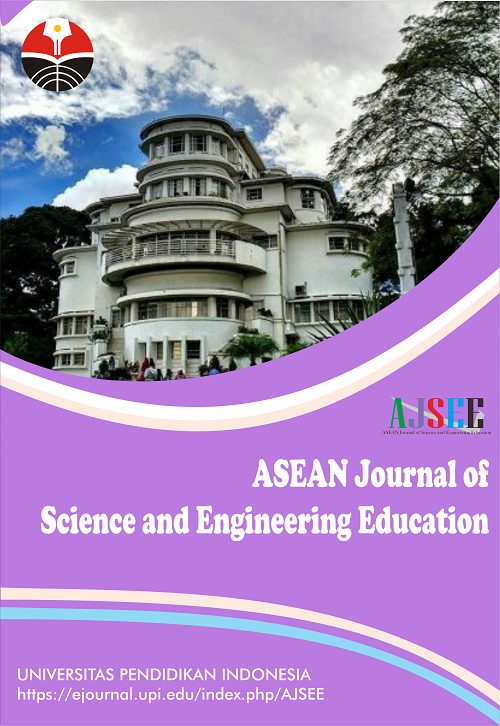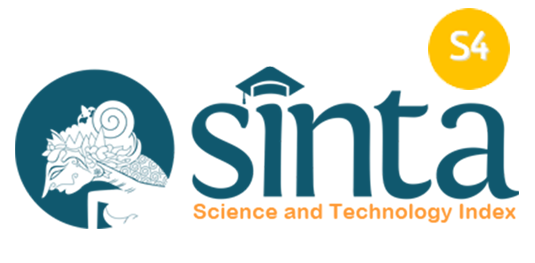The Integration of the Engineering Design Process in Biology-related STEM Activity: A Review of Thai Secondary Education
Abstract
STEM education is an effective instructional approach to multidimensionally develop students. Although the engineering discipline (E) in STEM education is ambiguously represented and integrated in the field of biological concepts in secondary education, the engineering design process (EDP) is showing potential to clearly guide educators to incorporate the EDP in biological classes. Thus, this review paper proposes to offer ideas of integrating EDP into biology-related STEM lessons in the context of Thai secondary education. It also outlines benefits and challenges of EDP integration which may assist teachers during designing lessons. The gathered results of prior research suggest that the EDP has potential to provide experiences focused on multidisciplinary real-life circumstances via hands-on activities in order to investigate solutions to problems. The challenges are greater to integrate EDP into biological tasks than other disciplines because of the nature of the content. Due to the ambiguity of integration, professional development programs, the implementation of suitable life-science content, and biological inspiration would assist teachers in conducting high-quality biological STEM activities which incorporate EDP. Moreover, time constraints, teachers’ negative attitudes, and a lack of resources should be addressed as barriers to consider before the implementation.
Keywords
Full Text:
PDFReferences
Alfonseca, E., Carro, R. M., Martín, E., Ortigosa, A., & Paredes, P. (2006). The impact of learning styles on student grouping for collaborative learning: a case study. User Modeling and User-Adapted Interaction, 16(3-4), 377-401.
Aranda, M. L., Lie, R., & Guzey, S. S. (2020). Productive thinking in middle school science students’ design conversations in a design-based engineering challenge. International Journal of Technology and Design Education, 30(1), 67-81.
Aranda, M. L., Lie, R., Guzey, S. S., Makarsu, M., Johnston, A., & Moore, T. J. (2020). Examining teacher talk in an engineering design-based science curricular unit. Research in Science Education, 50(2), 469-487.
Aschbacher, P. R., Li, E., & Roth, E. J. (2010). Is science me? High school students' identities, participation and aspirations in science, engineering, and medicine. Journal of Research in Science Teaching: The Official Journal of the National Association for Research in Science Teaching, 47(5), 564-582.
Barak, M. (2004). Systematic approaches for inventive thinking and problem-solving: Implications for engineering education. International Journal of Engineering Education, 20(4), 612-618.
Bilici, S. C., Küpeli, M. A., & Guzey, S. S. (2021). Inspired by nature: an engineering design-based biomimicry activity. Science Activities, 1–12.
Burghardt, M. D., & Hacker, M. (2004). Informed Design: A Contemporary Approach to Design Pedagogy. The Technology Teacher, 64(1).
Capraro, R. M., Capraro, M. M., & Morgan, J. R. (2013). STEM project-based learning. An Integrated Science, Technology, Engineering, and Mathematics (STEM) Approach, 2.
Carlson, L. E., & Sullivan, J. F. (2004). Exploiting design to inspire interest in engineering across the K-16 engineering curriculum. International Journal of Engineering Education, 20(3), 372-378.
Cimer, A. (2012). What makes biology learning difficult and effective: Students' views. Educational research and reviews, 7(3), 61.
Committee on Public Understanding of Engineering Messages, A. (2008). Execusive summary. In Changing the conversation: messages for improving public understanding of engineering (pp. 1–16). National Academies Press.
Cunningham, C. M. (2009). Engineering is elementary. The bridge, 30(3), 11-17.
Dixon, R. A., & Brown, R. A. (2012). Transfer of Learning: Connecting Concepts during Problem Solving. Journal of Technology Education, 24(1), 2-17.
Eekels, J., & Roozenburg, N. F. (1991). A methodological comparison of the structures of scientific research and engineering design: their similarities and differences. Design studies, 12(4), 197-203.
English, L. D., & King, D. T. (2015). STEM learning through engineering design: fourth-grade students’ investigations in aerospace. International Journal of STEM Education, 2(1), 1-18.
Fan, S. C., Yu, K. C., & Lin, K. Y. (2020). A framework for implementing an engineering-focused STEM curriculum. International Journal of Science and Mathematics Education, 1-19.
Fortus, D., Dershimer, R. C., Krajcik, J., Marx, R. W., & Mamlok-naaman, R. (2004). Design-based science and student learning. Journal of Research in Science Teaching, 41(10), 1081–1110.
Ghaemi, F., & Mirsaeed, S. J. G. (2017). The Impact of Inquiry-based Learning approach on Critical Thinking Skill of EFL Students. EFL JOURNAL, 2(2), 89–102.
Guzey, S. S., Moore, T. J., & Harwell, M. (2016). Building up STEM: an analysis of teacher-developed engineering design-based STEM integration curricular materials. Journal of Pre-College Engineering Education Research, 6(1), 11–29.
Guzey, S. S., Moore, T. J., Harwell, M., & Moreno, M. (2016). STEM integration in middle school life science: student learning and attitudes. Journal of Science Education and Technology, 25(4), 550–560.
Guzey, S. S., Roehrig, G., & Wang, H. (2014). A high-quality professional development for teachers of grades 3 – 6 for implementing engineering into classrooms. School Science and Mathematics, 114(3), 139–149.
Hafiz, N. R. M., & Ayop, S. K. (2019). Engineering Design Process in Stem Education: A Systematic Review. International Journal of Academic Research in Business & Social Sciences, 9(5), 676–697.
Hammer, D., & Schifter, D. (2001). Practices of inquiry in teaching and research. Cognition and Instruction, 19(4), 441–478.
Honey, M., Pearson, G., & Schweingruber, H. (2014). STEM integration in K-12 education: status, prospects, and an agenda for research. The National Academies press.
Householder, D. L., & Hailey, C. E. (2012). Incorporating engineering design challenges into STEM courses.
Hynes, M., Portsmore, M., Dare, E., Milto, E., Rogers, C., & Hammer, D. (2011). Infusing engineering design into high school STEM courses.
Jonassen, D., Strobel, L., & Lee, C. B. (2006). Everyday problem solving in engineering: lessons for engineering educators. Journal of Engineering Education, 95(2), 139–151.
Jones, R. W. (2006). Problem-based learning: description, advantages, disadvantages, scenarios and facilitation. Anaesth and Intensive Care, 34(4), 485–488.
Kelley, T. R., & Knowles, J. G. (2016). A conceptual framework for integrated STEM education. International Journal of STEM Education, 3(11), 1–11.
Kertil, M., & Gurel, C. (2016). Mathematical Modeling: A Bridge to STEM Education. International Journal of Education in Mathematics Science and Technology, 4(1), 44–55.
Laforce, M., Noble, E., King, H., Century, J., Blackwell, C., Holt, S., Ibrahim, A., & Loo, S. (2018). The eight essential elements of inclusive STEM high schools. International Journal of STEM Education, 3(21), 1–11.
Lazarowitz, R., & Penso, S. (1992). High school students’ difficulties in learning biology concepts. Journal of Biological Education, 26(3), 215–223.
Moll, L. C., Amanti, C., Neff, D., & Gonzalez, N. (1992). Funds of knowledge for teaching: using a qualitative approach to connect homes and classrooms. Theory into Practice, 31(2), 132–141.
Moore, T. J., Stohlmann, M. S., Wang, H., Tank, K. M., Glancy, A. W., & Roehrig, G. H. (2014). Implementation and integration of engineering in K-12 STEM education. In S. Purzer, J. Strobel, & M. Cardella (Eds.), Engineering in Pre-College Settings: Synthesizing Research, Policy, and Practices (pp. 35–60). Purdue University Press.
Noiwong, W., & Wongthong, P. (2020). Learning activity based on STEAM Education that emphasizes engineering design process in topic of hydroponics for enhancing 21st century skills of upper elementary school students. Journal of Science and Science Education, 3(2), 177–189.
Ratchawet, A., Suphimas, M., & Chaijalearn, Y. (2019). An action research on a STEM education learning with an enginnering design process in comjunction with local wisdom for lower secondary school students. Journal of Graduate Research, 10(1), 41–55.
Roehrig, G. H., Moore, T. J., Wang, H.-H., & Park, M. S. (2012). Is adding the E enough? Investigating the impact of K-12 engineering standards on the implementation of STEM integration. School Science and Mathematics, 112(1), 31–44.
Ropohl, G. (1997). Knowledge types in technology. International Journal of Technology and Design Education, 7, 65–72.
Salzman, H. (2013). What Shortages?: The Real Evidence about the STEM Workforce. Issues in Science and Technology, 29(3), 58–67.
Sneider, C. (2012). Core ideas of engineering and technology: understanding a framework for K-12 science education. The Science Teachercience, 32, 8–12.
Srikoom, W., Faikhamta, C., & Hanuscin, D. L. (2018). Dimensions of effective STEM integrated teaching practice. K-12 STEM Education, 4(2), 313–330.
Srikoom, W., Hanuscin, D. L., & Faikhamta, C. (2017). Perceptions of in-service teachers toward teaching STEM in Thailand. Asia-Pacific Forum on Science Learning and Teaching, 18(2), 1–24.
Tidma, P., Nakkuntod, M., & Kijkuakul, S. (2015). STEM education in topic of human systems to promote creative thinking of 8th grade students. Ratchaphruek Journal, 13(3), 71–76.
Wendell, K. B., & Rogers, C. (2013). Engineering design-based science, science content performance, and science attitudes in elementary school. Journal of Engineering Education, 102(4), 513–540.
White, D. W. (2014). What is STEM education and Why is it important?. Florida Association of Teacher Educators Journal, 1, 1–9.
Yadav, A., Subedi, D., Lundeberg, M. A., & Bunting, C. F. (2011). Problem-based Learning : influence on students’ learning in an electrical engineering. Journal of Engineering Education, 100(2), 253–280.
DOI: https://doi.org/10.17509/ajsee.v2i1.35097
Refbacks
- There are currently no refbacks.
Copyright (c) 1970 Universitas Pendidikan Indonesia

This work is licensed under a Creative Commons Attribution-ShareAlike 4.0 International License.














